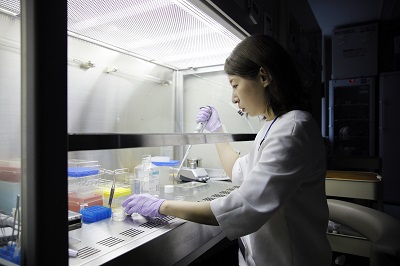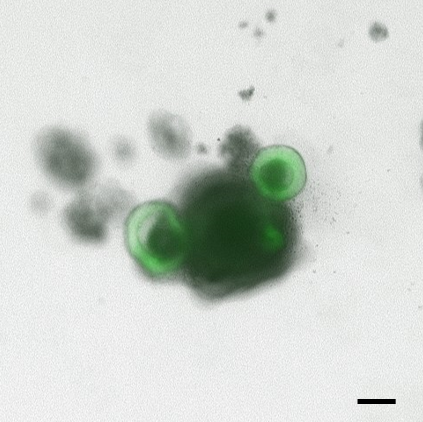Intercellular communication and transcription regulation
Why can salamanders regenerate their limbs and humans cannot?
A decade of biological sciences

Kazuko Okamoto, Assistant Professor
Kazuko Okamoto joined the WPI-NanoLSI in April 2020. “After my undergraduate studies in biological sciences at Hiroshima University, I moved to Kyoto University for my masters and doctoral degrees,” says Okamoto. “In 2013, after completing my doctorate, I started my post-doc at RIKEN in Osaka, and later at the RIKEN-Hiroshima University Research Collaboration Research Facility, before moving to the NanoLSI at Kanazawa University this Spring. It’s been a busy decade during which I started studying developmental biology at university and moved to cell biology at RIKEN.”
Specific research areas covered by Okamoto include embryogenesis of sea urchins as model animals focusing on insulator binding proteins and gene regulatory sequences at Hiroshima University; stem cell systems in invertebrates such as sponges (porifera) and flatworms (planarians) at Kyoto University [1]; and expression heterogeneity and single cell analysis in mouse ES cells and human and mouse iPS cells at RIKEN [2].
After her doctorate, Okamoto joined the RIKEN Center for Biosystems Dynamics Research (BDR) in Osaka, where the focus was on the development of microscopes and imaging technology for quantitative observation of the dynamics of living biological systems. “This was my first opportunity to use sophisticated microscopes for biological applications,” says Okamoto. “I saw how members of the group made their own unique microscopes. Eventually, I started to use super resolution microscopes for analysis of collective phenomena in mouse stem cells, especially in cell-cell communication and expression fluctuations. In 2018, I published my results in Science Reports [2].” Specifically, during her three years at RIKEN, Okamoto studied the visualization and measurement of molecular dynamics of transcription factors in living cellular nuclei focusing on the relationship between the molecular dynamics of transcription factors and cellular states. “Now looking back, I have experience in stem cells, genome, transcription regulation, and cell-cell communication.”
Organoids at the NanoLSI
At the WPI-NanoLSI, Okamoto is working with Associate Professor Satoru Okuda who is an expert in the control of three-dimensional multicellular dynamics by stem cell organoids and dynamics simulation [3]. Notably, Okamoto will study the perturbation of gene expression and morphology to answer the question of how morphology regulates gene expression. “Organoids and a mechano-biological approach may even offer more insights into why the brain so wrinkled,” says Okamoto.

Expression heterogeneity in a mouse ES colony. Upper panel: BF image. Lower panel: fluorescent confocal image. (Green: Nanog. Magenta: Oct4)
Both transcription factors, Nanog and Oct4 are involved in the maintenance of pluripotency in ES cells and iPS cells. The expression heterogeneity is recently thought to contain biological meanings. Okamoto. 2018 suggested that expression heterogeneity is reflected the cell-cell communication and intrinsic noise, and the heterogeneity contributes collective differentiation of all cells in a colony.

optic cup development in vivo. (Green: expression of retinal Rx promoter)
The generation of organoid mimicking retinal differentiation succeeded in 2011 (Eiraku et al. 2011). In the present, various types of organoids have been established. The organoid technology including retinal differentiation can be used as in vitro model for basic developmental studies.
Salamanders and a career in biology
Okamoto recalls that she did not have a particular interest in biology during her junior high school days. “But at high school, I remember being fascinated by a salamander that was kept by a teacher at the school,” says Okamoto. “I discovered that its legs regrew if they were to be torn off and I wondered why they did so. This may have been the trigger that led to my interest in biology, and in genetic transcription; my hands would not grow back but salamander’s do even though we follow the same genetic process of cellular growth.”
Women in science
Okamoto says that she has not had any gender issues during her career but she has noticed fewer female colleagues now compared to her grad-school days.
“I think the main reason for fewer female research scientists is that women tend to be more pragmatic about their lives than out male counterparts,” says Okamoto. “So, women may have a tendency to take less risks, for example, it’s less of a risk to join a company after graduation than to start a career in research, where the future is much less certain. In my case, I am looking forward to contributing to research at the WPI-NanoLSI. And I enjoy hiking, so I am looking for challenging mountain trails in Kanazawa.”
References
- Kazuko Okamoto et al, The active stem cell specific expression of sponge Musashi homolog EflMsiA suggests its involvement in maintaining the stem cell state, Mechanisms of Development, 129, pp. 24-37, (2012).
https://doi.org/10.1016/j.mod.2012.03.001
- Kazuko Okamoto et al, Single cell analysis reveals a biophysical aspect of collective cellstate transition in embryonic stem cell differentiation, Scientific Reports, 8:11965, (2018).
https://doi.org/10.1038/s41598-018-30461-2
- Profile of Satoru Okuda describing his research on organoids and the “Control of three-dimensional multicellular dynamics by stem cell organoids and dynamics simulation”.
https://nanolsi.kanazawa-u.ac.jp/en/researcher/satoru-okuda/

